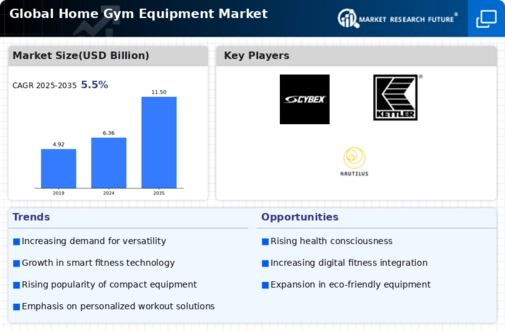-
EXECUTIVE SUMMARY
-
MARKET INTRODUCTION
-
Market Definition
-
Scope of the Study
- Research Objectives
- Assumptions & Limitations
-
Market Structure
-
MARKET RESEARCH METHODOLOGY
-
Research Process
-
Secondary Research
-
Primary Research
-
Forecast Model
-
MARKET LANDSCAPE
-
Supply Chain Analysis
- Raw Material Suppliers
- Manufacturers/Producers
- Distributors/Retailers/Wholesalers/E-Commerce
- End Users
-
Porter’s Five Forces Analysis
- Threat of New Entrants
- Bargaining Power of Buyers
- Bargaining Power of Suppliers
- Threat of Substitutes
- Internal Rivalry
-
MARKET DYNAMICS OF THE GLOBAL HOME GYM EQUIPMENT MARKET
-
Introduction
-
Drivers
-
Restraints
-
Opportunities
-
Challenges
-
GLOBAL HOME GYM EQUIPMENT MARKET, BY EQUIPMENT TYPE
-
Introduction
-
Cardiovascular Training Equipment
- Treadmills
- Elliptical Trainers
- Exercise Bikes
- Rowing Machines
- Stairs Machines
- Upper Body Trainers
- Others
- Cardiovascular Training Equipment: Market Estimates & Forecast, by Type, 2024–2032
- Cardiovascular Training Equipment: Market Estimates & Forecast, by Region, 2024–2032
-
Strength Training Equipment
- Extension Machines
- Multigyms & Cable Stations
- Benches & Racks
- Free Weights
- Plate Loaded
- Others
- Strength Training Equipment: Market Estimates & Forecast, by Type, 2024–2032
- Strength Training Equipment: Market Estimates & Forecast, by Region, 2024–2032
-
Other Equipment
- Other Equipment: Market Estimates & Forecast, 2024–2032
- Other Equipment: Market Estimates & Forecast, by Region, 2024–2032
-
GLOBAL HOME GYM EQUIPMENT MARKET, BY DISTRIBUTION CHANNEL
-
Introduction
-
Store-Based
- Store-Based: Market Estimates & Forecast, 2024–2032
- Store-Based: Market Estimates & Forecast, by Region, 2024–2032
- Hypermarkets & Supermarkets
- Specialty Stores
- Others
-
Non-Store-Based
- Non-Stored Based: Market Estimates & Forecast, by Region, 2024–2032
-
GLOBAL HOME GYM EQUIPMENT MARKET, BY REGION
-
Introduction
-
North America
- Market Estimates & Forecast, 2024–2032
- Market Estimates & Forecast, by Equipment Type, 2024–2032
- Market Estimates & Forecast, by Distribution Channel, 2024–2032
- Market Estimates & Forecast, by Country, 2024–2032
- US
- Canada
- Mexico
-
Europe
- Market Estimates & Forecast, 2024–2032
- Market Estimates & Forecast, by Equipment Type, 2024–2032
- Market Estimates & Forecast, by Distribution Channel, 2024–2032
- Market Estimates & Forecast, by Country, 2024–2032
- Germany
- UK
- France
- Spain
- Italy
- Rest of Europe
-
Asia-Pacific
- Market Estimates & Forecast, 2024–2032
- Market Estimates & Forecast, by Equipment Type, 2024–2032
- Market Estimates & Forecast, by Distribution Channel, 2024–2032
- Market Estimates & Forecast, by Country, 2024–2032
- China
- Japan
- India
- Australia & New Zealand
- Rest of Asia-Pacific
-
Rest of the World
- Market Estimates & Forecast, 2024–2032
- Market Estimates & Forecast, by Equipment Type, 2024–2032
- Market Estimates & Forecast, by Distribution Channel, 2024–2032
- Market Estimates & Forecast, by Region, 2024–2032
- South America
- Middle East
- Africa
-
COMPETITIVE LANDSCAPE
-
Introduction
-
Market Strategy
-
Key Development Analysis
-
(Expansions/Mergers & Acquisitions/Joint Ventures/New Product Developments/Agreements/Investments)
-
COMPANY PROFILES
-
Cybex International, Inc.
- Company Overview
- Financial Updates
- Product/Business Segment Overview
- Strategies
- Key Developments
- SWOT Analysis
-
Icon Health & Fitness, Inc.
- Company Overview
- Financial Updates
- Product/Business Segment Overview
- Strategies
- Key Developments
- SWOT Analysis
-
Nautilus, Inc.
- Company Overview
- Financial Updates
- Product/Business Segment Overview
- Strategies
- Key Developments
- SWOT Analysis
-
Technogym S.p.A
- Company Overview
- Financial Updates
- Product/Business Segment Overview
- Strategies
- Key Developments
- SWOT Analysis
-
Johnson Health Tech. Co., Ltd.
- Company Overview
- Financial Updates
- Product/Business Segment Overview
- Strategies
- Key Developments
- SWOT Analysis
-
Amer Sports Oyj
- Company Overview
- Financial Updates
- Product/Business Segment Overview
- Strategies
- Key Developments
- SWOT Analysis
-
True Fitness Technology, Inc.
- Company Overview
- Financial Updates
- Product/Business Segment Overview
- Strategies
- Key Developments
- SWOT Analysis
-
Vectra Fitness Parts LLC.
- Company Overview
- Financial Updates
- Product/Business Segment Overview
- Strategies
- Key Developments
- SWOT Analysis
-
HOIST Fitness Systems, Inc.
- Company Overview
- Financial Updates
- Product/Business Segment Overview
- Strategies
- Key Developments
- SWOT Analysis
-
Tunturi New Fitness B.V.
- Company Overview
- Financial Updates
- Product/Business Segment Overview
- Strategies
- Key Developments
- SWOT Analysis
-
Fitness EM LLC.
- Company Overview
- Financial Updates
- Product/Business Segment Overview
- Strategies
- Key Developments
- SWOT Analysis
-
Kettler (GB) Limited
- Company Overview
- Financial Updates
- Product/Business Segment Overview
- Strategies
- Key Developments
- SWOT Analysis
-
Impulse (Qingdao) Health Tech Co., Ltd.
- Company Overview
- Financial Updates
- Product/Business Segment Overview
- Strategies
- Key Developments
- SWOT Analysis
-
DHZ Fitness Europe GmbH
- Company Overview
- Financial Updates
- Product/Business Segment Overview
- Strategies
- Key Developments
- SWOT Analysis
-
Hammer Sport AG
- Company Overview
- Financial Updates
- Product/Business Segment Overview
- Strategies
- Key Developments
- SWOT Analysis
-
APPENDIX
-
General Sources & References
-
List of Abbreviations
-
LIST OF TABLES
-
Global Home Gym Equipment Market, by Region, 2024–2032 (USD Million)
-
Global Home Gym Equipment Market, by Equipment Type, 2024–2032 (USD Million)
-
Global Home Gym Equipment Market, by Distribution Channel, 2024–2032 (USD Million)
-
North America: Home Gym Equipment Market, by Country, 2024–2032 (USD Million)
-
North America: Home Gym Equipment Market, by Equipment Type, 2024–2032 (USD Million)
-
North America: Home Gym Equipment Market, by Distribution Channel, 2024–2032 (USD Million)
-
US: Home Gym Equipment Market, by Equipment Type, 2024–2032 (USD Million)
-
US: Home Gym Equipment Market, by Distribution Channel, 2024–2032 (USD Million)
-
Canada: Home Gym Equipment Market, by Equipment Type, 2024–2032 (USD Million)
-
Canada: Home Gym Equipment Market, by Distribution Channel, 2024–2032 (USD Million)
-
Mexico: Home Gym Equipment Market, by Equipment Type, 2024–2032 (USD Million)
-
Mexico: Home Gym Equipment Market, by Distribution Channel, 2024–2032 (USD Million)
-
Europe: Home Gym Equipment Market, by Country, 2024–2032 (USD Million)
-
Europe: Home Gym Equipment Market, by Equipment Type, 2024–2032 (USD Million)
-
Europe: Home Gym Equipment Market, by Distribution Channel, 2024–2032 (USD Million)
-
Germany: Home Gym Equipment Market, by Equipment Type, 2024–2032 (USD Million)
-
Germany: Home Gym Equipment Market, by Distribution Channel, 2024–2032 (USD Million)
-
France: Home Gym Equipment Market, by Equipment Type, 2024–2032 (USD Million)
-
France: Home Gym Equipment Market, by Distribution Channel, 2024–2032 (USD Million)
-
Italy: Home Gym Equipment Market, by Equipment Type, 2024–2032 (USD Million)
-
Italy: Home Gym Equipment Market, by Distribution Channel, 2024–2032 (USD Million)
-
Spain: Home Gym Equipment Market, by Equipment Type, 2024–2032 (USD Million)
-
Spain: Home Gym Equipment Market, by Distribution Channel, 2024–2032 (USD Million)
-
UK: Home Gym Equipment Market, by Equipment Type, 2024–2032 (USD Million)
-
UK: Home Gym Equipment Market, by Distribution Channel, 2024–2032 (USD Million)
-
Rest of Europe: Home Gym Equipment Market, by Equipment Type, 2024–2032 (USD Million)
-
Rest of Europe: Home Gym Equipment Market, by Distribution Channel, 2024–2032 (USD Million)
-
Asia-Pacific: Home Gym Equipment Market, by Country, 2024–2032 (USD Million)
-
Asia-Pacific: Home Gym Equipment Market, by Equipment Type, 2024–2032 (USD Million)
-
Asia-Pacific: Home Gym Equipment Market, by Distribution Channel, 2024–2032 (USD Million)
-
China: Home Gym Equipment Market, by Equipment Type, 2024–2032 (USD Million)
-
China: Home Gym Equipment Market, by Distribution Channel, 2024–2032 (USD Million)
-
India: Home Gym Equipment Market, by Equipment Type, 2024–2032 (USD Million)
-
India: Home Gym Equipment Market, by Distribution Channel, 2024–2032 (USD Million)
-
Japan: Home Gym Equipment Market, by Equipment Type, 2024–2032 (USD Million)
-
Japan: Home Gym Equipment Market, by Distribution Channel, 2024–2032 (USD Million)
-
Australia & New Zealand: Home Gym Equipment Market, by Equipment Type, 2024–2032 (USD Million)
-
Australia & New Zealand: Home Gym Equipment Market, by Distribution Channel, 2024–2032 (USD Million)
-
Rest of Asia-Pacific: Home Gym Equipment Market, by Equipment Type, 2024–2032 (USD Million)
-
Rest of Asia-Pacific: Home Gym Equipment Market, by Distribution Channel, 2024–2032 (USD Million)
-
Rest of the World (RoW): Home Gym Equipment Market, by Region, 2024–2032 (USD Million)
-
Rest of the World (RoW): Home Gym Equipment Market, by Equipment Type, 2024–2032 (USD Million)
-
Rest of the World (RoW): Home Gym Equipment Market, by Distribution Channel, 2024–2032 (USD Million)
-
South America: Home Gym Equipment Market, by Equipment Type, 2024–2032 (USD Million)
-
South America: Home Gym Equipment Market, by Distribution Channel, 2024–2032 (USD Million)
-
Middle East: Home Gym Equipment Market, by Equipment Type, 2024–2032 (USD Million)
-
Middle East: Home Gym Equipment Market, by Distribution Channel, 2024–2032 (USD Million)
-
Africa: Home Gym Equipment Market, by Equipment Type, 2024–2032 (USD Million)
-
Africa: Home Gym Equipment Market, by Distribution Channel, 2024–2032 (USD Million)
-
LIST OF FIGURES
-
Global Home Gym Equipment Market Segmentation
-
Forecast Research Methodology
-
Five Forces Analysis of the Global Home Gym Equipment Market
-
Value Chain of the Global Home Gym Equipment Market
-
Share of the Global Home Gym Equipment Market in 2024, by Country (%)
-
Global Home Gym Equipment Market, by Region, 2024–2032
-
Global Home Gym Equipment Market Size, by Equipment Type, 2024
-
Share of the Home Gym Equipment Market, by Equipment Type, 2024–2032 (%)
-
Global Home Gym Equipment Market Size, by Distribution Channel, 2024
-
Share of the Home Gym Equipment Market, by Distribution Channel, 2024–2032 (%)

















Leave a Comment